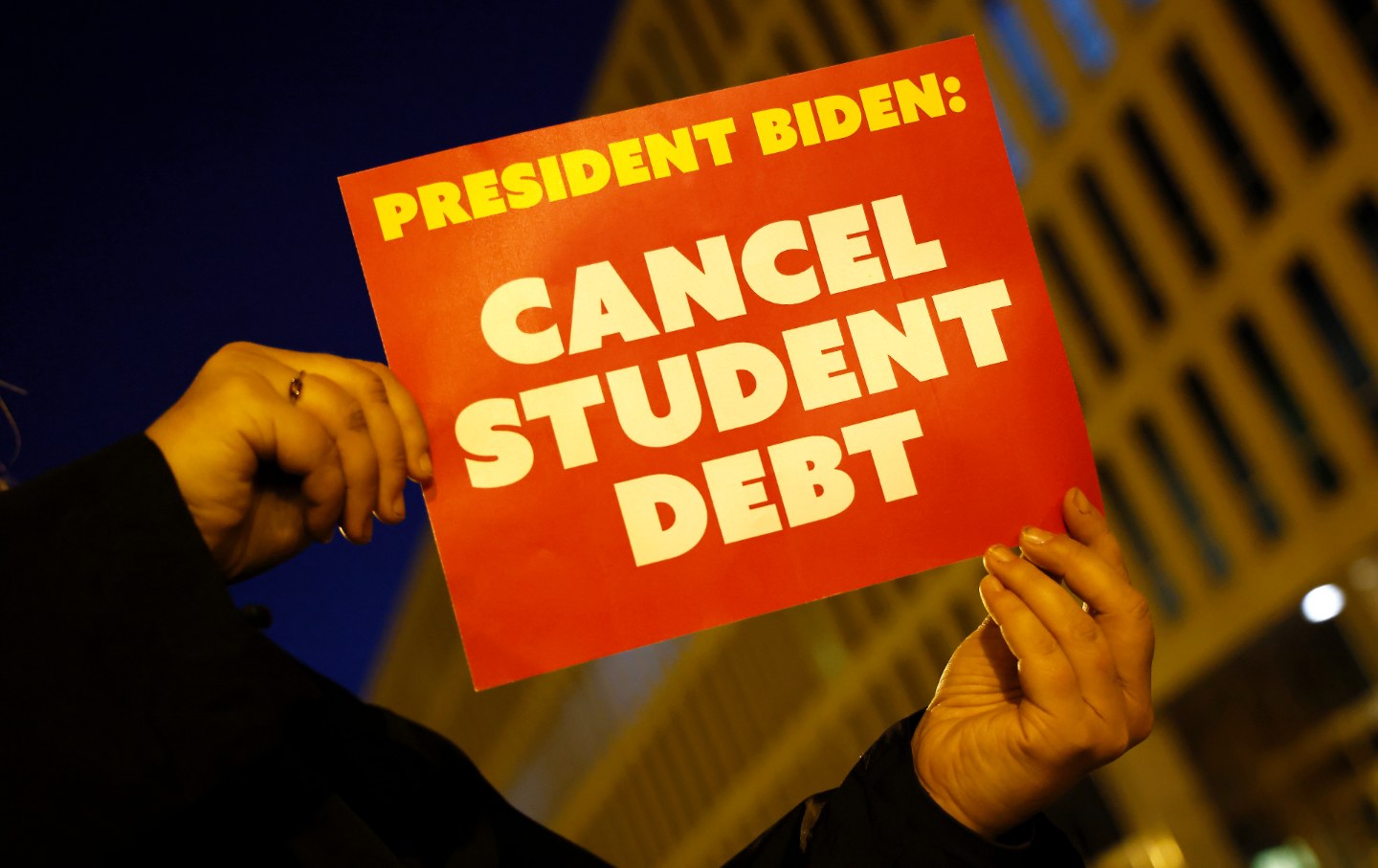
A sign outside of the US Department of Education celebrating the payment pause in March 2022.(Paul Morigi / Getty Images / We The 45 Million)
The past two years have seen record job growth, rising wages, and increasing bargaining power for workers. But for millions of Americans, the enormous burden of debt is overshadowing those gains—and the struggles are more intense for women, and for Black and brown borrowers.
This story was produced for StudentNation, a program of the Nation Fund for Independent Journalism, which is dedicated to highlighting the best of student journalism. For more Student Nation, check out our archive or learn more about the program here. StudentNation is made possible through generous funding from The Puffin Foundation. If you’re a student and you have an article idea, please send pitches and questions to pitches@thenationfund.org.
Just ask the 45 million Americans carrying more than $1.7 trillion in student loan debt. They will share stories about the pandemic-related student loan payment pause helping them survive the economic shocks of the pandemic, as well as the fear that payments may suddenly restart. For some, they are just beginning to recover from lost jobs, health crises, and other forms of distress caused by the pandemic. For others, the recovery is still far out of reach.
Even though the payment pause for federal student loans was recently extended until August 31, many borrowers will find themselves struggling once more if the Biden administration holds back on more significant relief. In two recent reports, the Consumer Financial Protection Bureau found that over 5 million people face serious financial risk if payments resume, and the Federal Reserve says that loan defaults would spike for those facing the most difficulty.
As an advocate for people with student debt and an economist, respectively, we are painfully aware of the obstacles facing borrowers. At the Student Debt Crisis Center, we surveyed thousands of people and found that 85 percent still depend on the federal student loan payment pause—a clear indicator that many families are still struggling.
At the same time, Roosevelt Institute analysis of the student loan payment pause provides a glimpse of optimism and a hint of what’s possible if further action is taken. Freeing Americans from student loan payments supported the economic security of millions of borrowers and their families and allowed borrowers to keep $7.12 billion of their earned income every month.
A growing chorus of labor, civil rights, and consumer protection groups, and dozens of lawmakers, are urging the president to keep the momentum going by canceling student debt permanently. While the administration’s recent efforts with federal repayment plans and loan forgiveness programs are impactful, and long overdue, broad debt cancellation is the only plan that ensures relief reaches everyone who needs it.
Macroeconomic trends bear that out: The pandemic exacerbated the labor market inequities that harm people of color and women, and price increases due to pandemic-related supply chain disruptions and corporate-driven price hikes have undermined many of the gains of the economic recovery.
We recently spoke with Senate majority leader Chuck Schumer, who described student loan debt as “the shackle chaining millions of Americans to a life of debt and sinking billions from our economy every year,” and he agrees that student debt cancellation would have far-reaching benefits for our economy. “Canceling student loan debt would provide those Americans with a new lease on life and free them to achieve their dreams of buying a house, saving for their kids’ education, or start small businesses, and unleash a wave of economic activity missing from our country.”
The resumption of student debt payments after August 31 would undermine the economic recovery, and cause an avoidable trade-off between paying off debt and affording basic necessities. Student loan payments drain a monthly average of $393 from borrowers’ budgets, reducing household disposable income and savings. Black borrowers would face the greatest income and wealth losses if payments resumed, because they are more likely to borrow and to borrow at higher levels than white students. Amid these losses, the administration’s goal to “grow our economy from the bottom up and the middle out” will be difficult to meet.
Extending student loan relief beyond August would allow borrowers to navigate these challenging times without the extra shock of payments. Going further with permanent debt cancellation would help borrowers thrive long into the future. The Biden administration has the power to take such action immediately. The American economic recovery is not complete. Student debt relief and permanent debt cancellation are pivotal steps toward making America more prosperous and equitable. It’s time to build on the lessons of the two-year student loan payment pause and lock in the social and economic benefits of debt-free education for good.
Cody HounanianTwitterCody Hounanian is the executive director of Student Debt Crisis Center, working on issues like consumer protection policies and student loan refinancing.
Alí R. BustamanteAlí R. Bustamante is the Deputy Director of the Education, Jobs & Worker Power program at the Roosevelt Institute. His research and analysis have been featured on The New York Times, USA Today, NPR, CNN, Forbes, Charities USA, and other media outlets.